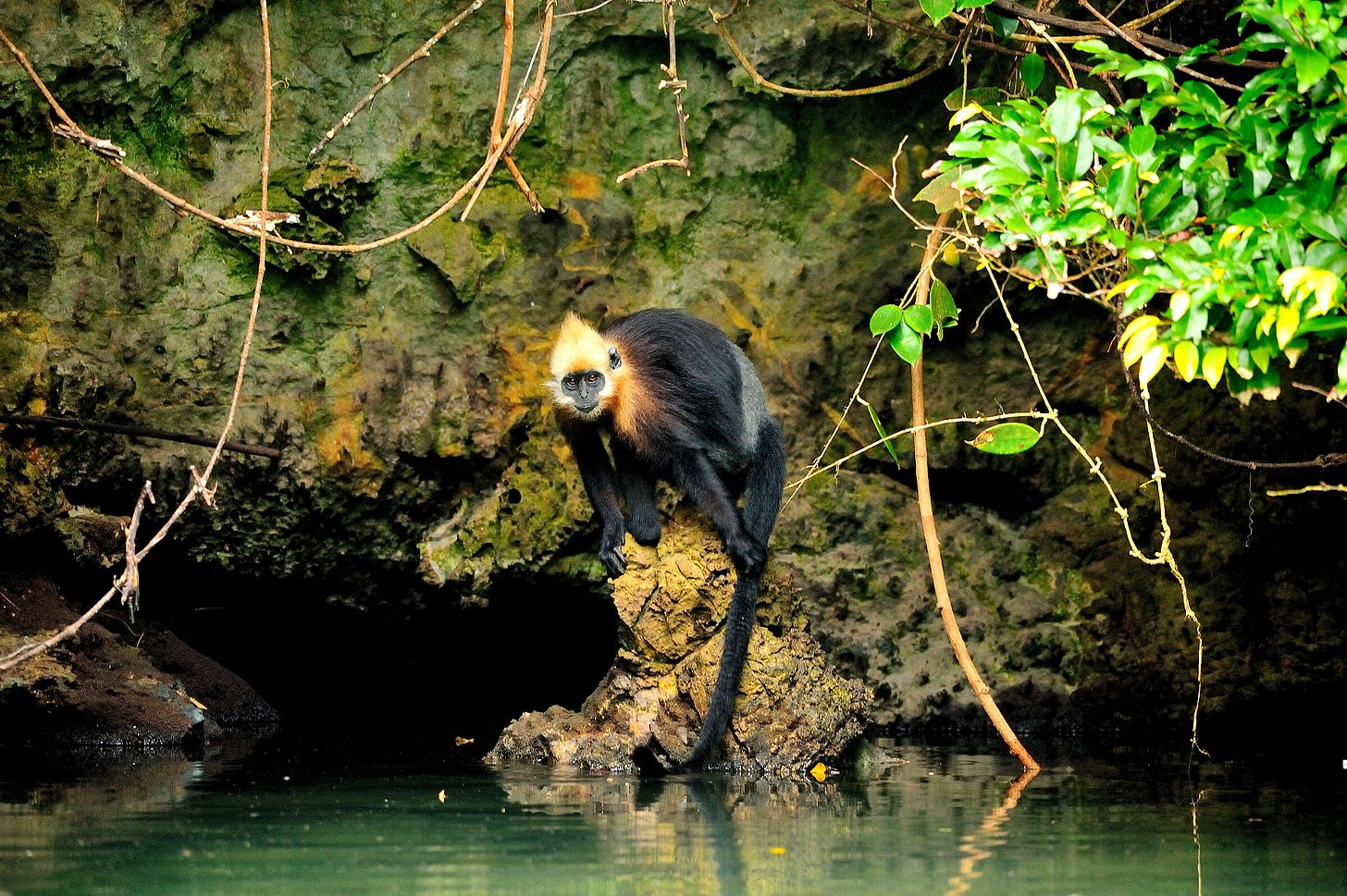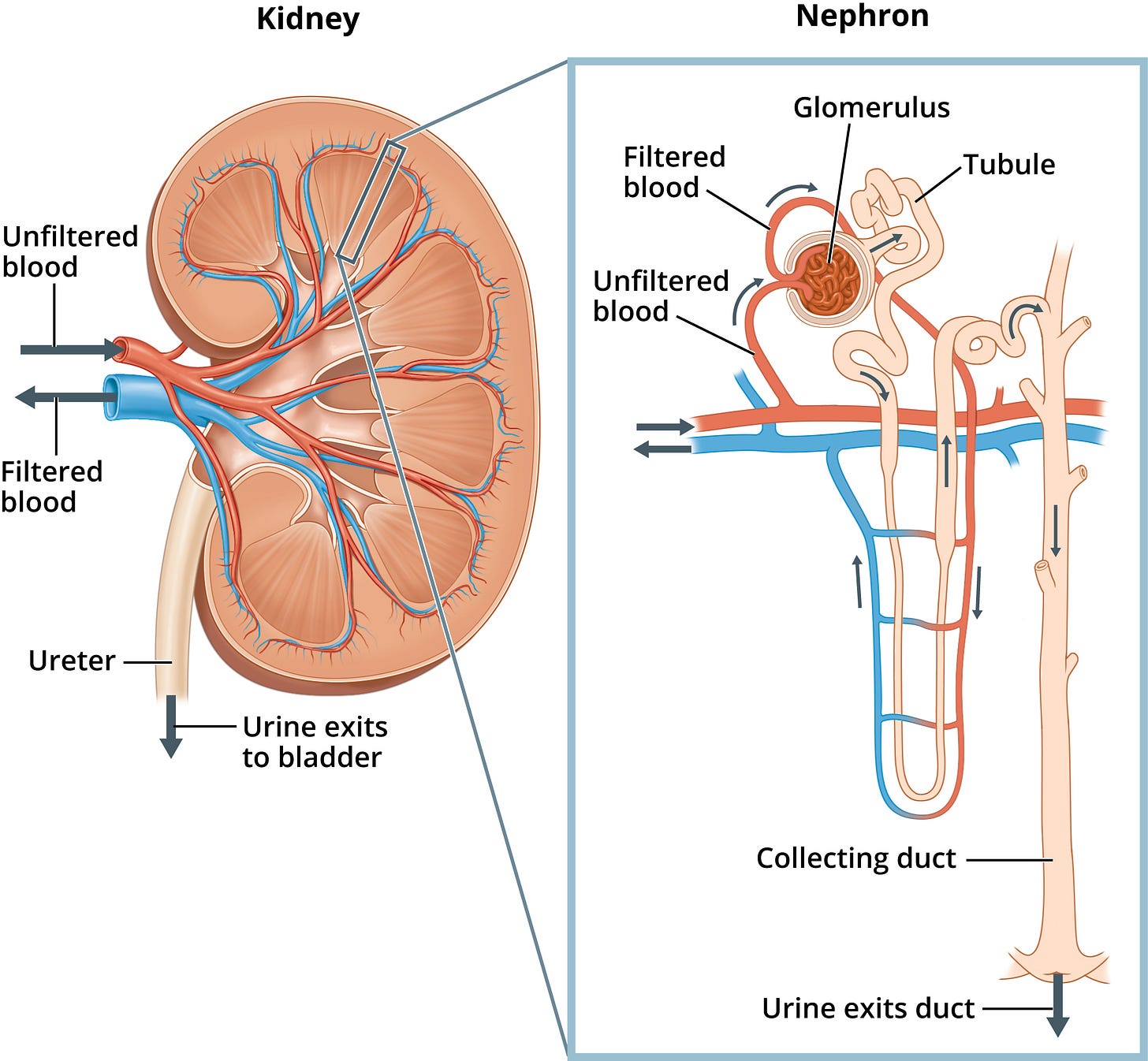Somewhere around 500,000 years ago, and possibly as recently as 12,000 years ago, Cat Ba langurs, a long tailed, leaf-eating primate, separated from Francois’ langur as a species. This probably had something to do with the fact that Cat Ba langurs found themselves on an isolated island (Cat Ba Island, unsurprisingly) off the coast of Northern Vietnam, separated from the mainland Francois’ langur by 15 miles of water.
There are advantages and disadvantages to living on Cat Ba Island, if you’re a Cat Ba langur. The advantage is that it has the limestone cliffs and caves that you’re used to, as well as the leaves and vegetation that you’re accustomed to eating. It also has fewer predators and less competition for resources.
The disadvantage is why it has less competition for resources: it has almost no water. While it is in a tropical climate, the limestone doesn’t hold the water well, and rainwater quickly drains away. During the dry season, there are no rivers, streams, or ponds whatsoever. For a primate, these are some tricky conditions. There’s a reason why there are almost no primates in deserts1.
The Cat Ba langur, amazingly enough, has adapted to these harsh conditions. It gets the water it needs from the vegetation it eats, despite the fact that they’re covered in salty spray. It also occasionally drinks mouthfuls of straight seawater.

Physiologically, this is a very surprising thing for a mammal to be able to do. Few mammals can survive for extended periods of time without freshwater. Even fewer mammals can drink seawater, and, outside of the Cat Ba langur and the Bactrian camel, those that can are all marine mammals2. And while all marine birds and reptiles can drink seawater, they rely on special organs to excrete salt, which mammals like the Cat Ba langur lack. So, just how does the Cat Ba langur drink seawater?
Before we can get into that, let’s talk about what would happen if you, dear reader, would try to do the same (or, for that matter, if a misplaced Francois langur would). A normal mouthful of seawater is about 15 mL, and contains about half a gram of salt, or about triple the amount of a personal sized bag of Lays potato chips. This is an unpleasant amount of salt, and it would burn as it went down, as anyone who’s swallowed a mouthful of seawater would know.
This seawater would make its way down your esophagus to your stomach to your small intestine. Along the way, it’d trigger various alarms in your system, as it’d contain about triple the sodium concentration of your stomach or small intestine. If you were really dehydrated or swallowed a full, cheeks bulging mouthful, it’d probably trigger vomiting, as this mouthful of seawater would contain enough sodium to significantly alter the sodium content of your stomach, messing with the osmotic balance and causing water to rush in.
Assuming you didn’t vomit, this seawater would start to be processed from your small intestine in minutes, as your body would quickly work to maintain a normal osmotic balance. About 98% of the sodium would make its way from your small intestine to your bloodstream, and from there to your interstitial and intracellular fluid. Once again, though, your body would notice the excess sodium concentration, as too much sodium surrounding cells causes water to rush out of them. Before that could happen, your body would get rid of that excess sodium.
It does this primarily through excretion through the kidneys in the form of urine. Your kidneys, if you’re unfamiliar, work through the process of filtration, reabsorption, secretion, and excretion. Going through these steps one-by-one:
Filtration: filtration is the first step. It’s pretty straightforward: your blood is forced through a membrane, which filters out all large parts of the blood that shouldn’t be peed out, namely proteins and blood cells. What’s left is ultrafiltrate.
Reabsorption: next is reabsorption. This is where the rest of what shouldn’t be peed out is reabsorbed back into the bloodstream. This includes glucose, amino acids, salt, and water. This is a much more fine-tunable step than filtration. All proteins and blood cells are supposed to be filtered out of your urine, which is why protein or blood in your urine is always a bad thing. Not all salt, water, glucose, or amino acids are supposed to be filtered out of your urine, although glucose or amino acids in your urine is a sign of a problem further upstream (e.g. diabetes).
This process is fine-tuned by vasopressin, or ADH. Increased levels of ADH causes three effects:
1. Insertion of aquaporins into the tubules of the kidney. Aquaporins are electrically charged channels that let water molecules through single file, but don’t let other ions through.
2. Increased levels of urea transporters, which, as the name suggests, removes urea, a nitrogen compound.
3. Increased reabsorption of sodium.
This is harder than it sounds, though. If you think about your osmotic gradient, you’ll quickly realize that, as soon as you remove water from the ultrafiltrate, you’re going to be left with a hyperconcentrated solution. Neither sodium nor urea is going to want to leave. In fact, water is going to want to rush in.
The key here is the countercurrent multiplication. As the ultrafiltrate moves along the kidney’s tubules and becomes more concentrated, the walls of the kidney become impervious to water, so it’s difficult for any more water to come in or out. Simultaneously, sodium, chloride, and potassium are pumped into the membrane outside of the kidney, creating a more concentrated solution outside of the loop of Henle, as it’s called, than inside. This makes sodium want to exit across the membrane.
And now you see the rub. This process works really well if it’s easy to make the interstitial fluid saltier than the concentrated ultrafiltrate. But if the ultrafiltrate is too salty before it’s even concentrated (i.e. if you’ve been drinking seawater), it makes this process harder to carry out.
We’ll get back to that in a sec. Just to finish this off, the kidneys also carry out secretion, or secreting the very hormones that regulate them, and excretion, or finally getting rid of the urine.

So, now that we’ve covered the basics of the kidney, I think you can see why you, as a human or a Francois langur would have trouble living the lifestyle of the Cat Ba langur. The lack of regular supply of water is hard enough. Every animal needs water. But, this can be solved by just getting really good at recycling water, like pretty much every desert creature does. This can be done by simply extending the loop of Henle to create ultra-concentrated filtrate and really draw almost all possible water out of the urine before excreting it.
But drinking salt water seems way harder. There’s a reason why almost no animals do it, even many marine mammals. How do the Cat Ba langurs accomplish it?
There are clues. I came across a paper recently (actually the inspiration for this essay) that explored the genomic differences between the Cat Ba langur and the Francois langur. The most important ones they found were in calcium signaling, calcium ion binding, and sodium transport handling.
The sodium transport makes sense, but the calcium handling stuff is stranger. The paper itself suggests it has to do with the limestone cliffs that the Cat Ba langurs live on, but the Francois langur lives on those exact sort of cliffs on the mainland. Plus, just living on calcium cliffs doesn’t mean you’re ingesting calcium that often.
I decided to take a different route in exploring this. I gave Claude the list of genes that were changed, without giving Claude any clues on what the species was. I wanted its unbiased opinion on whether it thought these changes were sufficient to explain the Cat Ba’s extraordinary lifestyle.
Note: I’ve paywalled past here as an experiment to see if people will pay for my content. There’s really only about 5 paragraphs left, which are about using Claude to speculate about this adaptation.
Keep reading with a 7-day free trial
Subscribe to Trevor Klee’s Newsletter to keep reading this post and get 7 days of free access to the full post archives.



